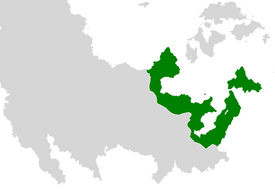User:Devink/sandbox6
Yajawil of Maok'ab Maok'ab | |||||||||
|---|---|---|---|---|---|---|---|---|---|
| 1660–1841 | |||||||||
 The Yajawil during the 18th century | |||||||||
| Status | Former province | ||||||||
| Common languages | Yokot'an | ||||||||
| Religion | White Path, traditional religions | ||||||||
| Government | Monarchy | ||||||||
| Historical era | Mutulese Ochran | ||||||||
• Established | 1660 | ||||||||
• Disestablished | 11th June 1841 | ||||||||
| |||||||||
The Yajawil of Maok'ab, more often shorten as "Maok'ab", was a Mutulese colonial province corresponding to much of the eastern coast of the Malaio continent. It notably encompassed the modern country of Onekawa-Nukanoa and the Province of Sina’uia. It was established following the development of the Mutulese presnece in Ochran and merged together a number of trade ports into a single administrative unit.
History
Government
Maoji Nalil
The "Maori Wards" (Mahoji Nalil in Mutli) were an administrative division created during the 18th century to solve the administrative and legal problems posed by the Maori emmigration to the Mutulese trade-ports. Maori who had settled in these cities were officialy granted citizenship and grouped into their own Wards. These Wards had their own leaders, bearing the official title of "Aj Kuchkab" like it was traditional for district leaders in the Mutul, and had their own School and Court of justice. In the following decades, smaller Maori settlements distant from the urban centers were also granted the official status of Nalil, with the citizenship it implied.
The Maori Wards greatly helped the Mutul root itself in Malaio and integrate the Maori to the larger "Vespanian Network" of the Mutuleses. It also eroded the traditional tribal lines and diminish the power of some of the more "Mutulese friendly" Iwi, which had their populations integrated to the cities and accounted in the census, while their leaders and "aristocracy" was integrated into the colonial administration.
Veterans Grants
A major policy of the Nuk Nahob was that all sailors and soldiers who served a full 7 years was elligible to receive a patch of farmland. They were not allowed to chose the location of the granted lands, and thus this policy resulted in a vast, Vespanian wide, intermixing of populations. There were two major "colonization centers" : the Protectorate of Ankat and the Maok'ab Yajawil, mostly because of the vast expands of widelands to clear and organize in both of these regions.
The Lands were generally granted so to form small autonomous communities, generally between two to three hundreds people, with their own Temples and School. The position of Aj Kuchkab, or Warden, of a new colony was granted to whoever had reached the highest rank during his service. To favour the implementation of these ex-soldiers, their settlements were often close by, or just in contact with, an older Ward or a large plantation owned by a Mutulese trader. These Wards were thus kept under Mutulese control by both vertical (their administrative and judicial existence, their clientelist relationship with large plantation owners who could loan them equipment, seeds, and offer insurances in case of disasters...) and horizontal ties (the "brotherhoods" formed with older implanted communities...) within the Mutulese structure.
The Veterans who were implanted in Maok'ab were almost never of Oxidentaleses origins. In fact, historians and demographs have sometime described the Yajawil as a "continuation of the Tahamaja Era": the colons were often of Pulaui and Tsurushimese origins, with a minority of Janatāva people. What tied these people together were their common veteranship and long service within the Nuk Nahob, a common tongue (already called Mutli but closer to Yokot'an than its modern counterpart), and a common religion as most, if not all, had converted to the White Path during their service by careerism or mere cultural osmosis. As a result, these colonies proved to be powerful vectors of transmission of the Mutulese culture.
Military
At first, the Mutuleses Nuk Nahob showed little interest in the Maori themselves, because of the low density of their populations and their lack of a naval tradition. With time, the Malaio natives ended up finding a place in the Mutulese military machine as low ranking soldiers, workers, and crew members. Generally, they were recruited to replace men lost during the journey from Oxidentale.
With the constitution of Maok'ab as its own Yajawil and the growth of the coastal cities, the Mutuleses were now able to create and levy specific "Maori Regiments". The "Mao Fusilliers" were all-volunteers recruited from the Nalil but also from the Iwi allied to the Mutuleses as well. Officers of these Regiments were originally either Oxidentaleses or Ochraneses people affected to these units, but as the integration of the Maori people grew, so did the portion of officers originating from a Maoji Nalil, while the "Oxidentaleses" were slowly but surely replaced by volunteers from the "Veterans Wards". Maori from "allied Iwi" however almost never rose above sub-officers because of their lack of education and poor grasp of Yokot'an.